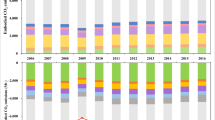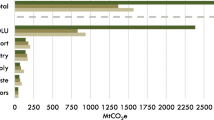Abstract
In the context of the rapid development of the Belt and Road (B&R) Initiative, the continuous transfer of Sino-US trade to the B&R countries is an important means to mitigate the threat of Sino-US trade, and the environmental impact of this transfer should be considered, so as to provide a scientific basis for China’s policy formulation about achieving this possible trade transfer with minimized environmental impacts. This study proposes a multiregional input-output model and analyzes the impact on carbon dioxide (CO2) emissions of transferring the Sino-US trade to the B&R countries for two types of scenarios. The results show the following: (1) A transfer of either the import trade or the export trade increases global and Chinese CO2 emissions by 81.76 Mt and 24.84 Mt, respectively. When both the import trade and export trade are transferred, the increases in CO2 emissions are only 0.22% and 0.26%, respectively. (2) Globally, the changes in international trade-embodied CO2 emissions are responsible for most of the global emission changes, especially the CO2 emissions exported from Russia, India, and many Southeast Asian countries to China. (3) Different from the impact on global emissions, the increases in Chinese domestic production-based CO2 emissions influence China’s total CO2 emissions. Due to the imported CO2 emissions, the consumption-based CO2 emissions are affected to a greater degree and increase by 70.30 Mt, accounting for only 0.86% of the CO2 emissions in 2015. Finally, some policy implications are proposed.









Similar content being viewed by others
Notes
When producing a certain product, the sum of the direct and indirect CO2 dioxide emitted in the entire production chain.
References
Arce G, López LA, Guan D (2016) Carbon emissions embodied in international trade: the post-China era. Appl Energy 184:1063–1072
Cai B, Guo H, Cao L, Guan D, Bai H (2018a) Local strategies for china’s carbon mitigation: an investigation of Chinese city-level CO2, emissions. J Clean Prod 178:890–902
Cai X, Che X, Zhu B, Zhao J, Xie R (2018b) Will developing countries become pollution havens for developed counties? An empirical investigation in the Belt and Road. J Clean Prod 198:624–632
Cheng H, Dong S, Li F, Yang Y, Li S, Li Y (2018) Multiregional input-output analysis of spatial-temporal evolution driving force for carbon emissions embodied in interprovincial trade and optimization policies: case study of northeast industrial district in China. Environ Sci Technol 52:346–358
Deng R, Chen M (2014) Study on the embodied carbon emission of Sino-US trade——based on the analysis of IO-SDA model. Econ Finan Manag 26:46–57 (in Chinese)
Dietzenbacher E, Pei J, Yang C (2012) Trade, production fragmentation, and China’s carbon dioxide emissions. J Environ Econ Manag 64:88–101
Dogan, E., & Inglesi-Lotz, R. (2020). The impact of economic structure to the environmental Kuznets curve (EKC) hypothesis: evidence from European countries. Environ Sci Pol. R.,1-8
Dogan E, Turkekul B (2016) CO2 emissions, real output, energy consumption, trade, urbanization and financial development: testing the EKC hypothesis for the USA. Environ Sci Pollut R 23(2):1203–1213
Dogan E, Taspinar N, Gokmenoglu KK (2019) Determinants of ecological footprint in MINT countries. Energy Environ 30(6):1065–1086
Du H, Guo J, Mao G, Smith AM, Wang X, Wang Y (2011) CO2 emissions embodied in China–US trade: input–output analysis based on the energy/dollar ratio. Energ Policy 39:5980–5987
Fan J-L, Xu M, Li F, Yang L, Zhang X (2018) Carbon capture and storage (CCS) retrofit potential of coal-fired power plants in China: the technology lock-in and cost optimization perspective. Appl Energy 229:326–334
Guan D, Peters GP, Weber CL, Hubacek K (2009) Journey to world top emitter: an analysis of the driving forces of China’s recent CO2 emissions surge. Geophys Res Lett 36
Guo J, Zou L-L, Wei Y-M (2010) Impact of inter-sectoral trade on national and global CO2 emissions: an empirical analysis of China and US. Energ Policy 38:1389–1397
Guo J, Zhang YJ, Zhang KB (2018a) The key sectors for energy conservation and carbon emissions reduction in China: evidence from the input-output method. J Clean Prod 179:180–190
Guo M, Lu L, Sheng L, Yu M (2018b) The day after tomorrow: evaluating the burden of Trump’s trade conflict. Asian Econ Pap 17:101–120
Han M, Yao Q, Liu W, Dunford M (2018) Tracking embodied carbon flows in the Belt and Road regions. J Geogr Sci 28:1263–1274
He K, Hertwich EG (2019) The flow of embodied carbon through the economies of China, the European Union, and the United States. Resour Conserv Recycl 145:190–198
International Energy Agency (IEA), 2018. World Energy Outlook 2018.https://www.iea.org/weo/ ()
International Energy Agency (IEA), 2019. @IEA 2020, https://www.iea.org/data-and-statistics?country=WORLD&fuel=CO2%20emissions&indicator=CO2%20emissions%20by%20energy%20source
Kanemoto K, Lenzen M, Peters GP, Moran DD, Geschke A (2011) Frameworks for comparing emissions associated with production, consumption, and international trade. Environ Sci Technol 46:172–179
Lenzen M, Kanemoto K, Moran D, Geschke A (2012) Mapping the structure of the world economy. Environ Sci Technol 46:8374–8381
Lenzen M, Moran D, Kanemoto K, Geschke A (2013) Building Eora: a global multi-region input–output database at high country and sector resolution. Econ Syst Res 25:20–49
Leontief W (1970) Environmental repercussions and the economic structure: an input-output approach. Rev Econ Stat 52:262–271
Li H, Li F, Yu X (2018) China’s contributions to global green energy and low-carbon development: empirical evidence under the Belt and Road framework. Energy 11
Li S, Zhou C, Wang S (2019) Does modernization affect carbon dioxide emissions? A panel data analysis. Sci Total Environ 663:426–435
Liu Y, Hao Y (2018) The dynamic links between CO2 emissions, energy consumption and economic development in the countries along “the Belt and Road”. Sci Total Environ 645:674–683
López LA, Arce G, Kronenberg T, Rodrigues JFD (2018) Trade from resource-rich countries avoids the existence of a global pollution haven hypothesis. J Clean Prod 175:599–611
Meng J, Mi Z, Guan D, Li J, Tao S, Li Y, Feng K, Liu J, Liu Z, Wang X, Zhang Q, Davis SJ (2018) The rise of South-South trade and its effect on global CO2 emissions. Nat Commun 9:1871
Mi Z, Meng J, Guan D, Shan Y, Song M, Wei YM, Liu Z, Hubacek K (2017) Chinese CO2 emission flows have reversed since the global financial crisis. Nat Commun 8:1712
Ministry of Commerce, 2018a. General Statistics - Gross Domestic Product (GDP). http://data.mofcom.gov.cn/zhtj/gdp.shtml ()
Ministry of Commerce, 2018b. A spokesperson for the Ministry of Commerce spoke on China's WTO recommendations on US 301 taxation. http://www.mofcom.gov.cn/article/ae/ag/201804/20180402728557.shtml ()
Ministry of Commerce, 2019a. Brief information on import and export in December. http://www.mofcom.gov.cn/article/tongjiziliao/cf/201902/20190202832959.shtml ()
Ministry of Commerce, 2019b. A spokesperson for the Ministry of Commerce made a statement on the official implementation of the tariff increase by the US. http://www.mofcom.gov.cn/article/ae/ag/201905/20190502861691.shtml ()
Moutinho V, Madaleno M, Inglesi-Lotz R, Dogan E (2018) Factors affecting CO2 emissions in top countries on renewable energies: a LMDI decomposition application. Renew Sust Energ Rev 90:605–622
National Information Center, 2018. “the Belt and Road” big data report 2018. http://www.sic.gov.cn/Column/614/0.htm()
Ouyang X, Lin B (2015) An analysis of the driving forces of energy-related carbon dioxide emissions in China’s industrial sector. Renew Sust Energ Rev 45:838–849
Peters GP (2008) From production-based to consumption-based national emission inventories. Ecol Econ 65:13–23
Peters GP (2010) Carbon footprints and embodied carbon at multiple scales. Curr Opin Environ Sustain 2:245–250
Peters G, Hertwich E (2008) CO2 embodied in international trade with implications for global climate policy. Foreign Policy Anal 65:13–23
Rauf A, Zhang J, Li J, Amin W (2018) Structural changes, energy consumption and carbon emissions in China: empirical evidence from ARDL bound testing model. Struct Change Econ D 47:194–206
Saud S, Chen S, Danish, Haseeb A (2019) Impact of financial development and economic growth on environmental quality: an empirical analysis from Belt and Road Initiative (BRI) countries. Environ Sci Pollut Res 26:2253–2269
Shao S, Yang L, Yu M, Yu M (2011) Estimation, characteristics, and determinants of energy-related industrial CO2 emissions in Shanghai (China), 1994–2009. Energ Policy 39:6476–6494
Shui B, Harriss RC (2006) The role of CO2 embodiment in US–China trade. Energ Policy 34:4063–4068
Su B, Ang BW (2010) Input–output analysis of CO2 emissions embodied in trade: the effects of spatial aggregation. Ecol Econ 70:10–18
Su B, Ang BW (2011) Multi-region input–output analysis of CO2 emissions embodied in trade: the feedback effects. Ecol Econ 71:42–53
Sun Q, Geng Y, Ma F, Wang C, Wang B, Wang X, Wang W (2018) Spatial–temporal evolution and factor decomposition for ecological pressure of carbon footprint in the One Belt and One Road. Sustainability 10
Wang Z, Zhu Y, Peng Y (2013) Carbon emissions trends with optimal balanced economic growth of China and the USA and some abatement options for China. J Geogr Sci 23:991–1004
Weber CL, Peters GP, Guan D, Hubacek K (2008) The contribution of Chinese exports to climate change. Energ Policy 36:3572–3577
Wu C, Huang X, Yang H, Lu Q, Xu G, Li L, Li J (2015) Embodied carbon emissions of foreign trade under the global financial crisis: a case study of Jiangsu province, China. J Renew Sustain Ener 7:043110
Zhang YJ, Zhang KB (2018) The linkage of CO2 emissions for China, EU, and USA: evidence from the regional and sectoral analyses. Environ Sci Pollut Res 25:0944–1344
Funding
This study was financially supported by the National Natural Science Foundation of China under Grant (no. 71874193, 71503249, 71203008), the Asia-Pacific Network for Global Change Research (no. CBA2018-02MY-Fan), Young Elite Scientists Sponsorship Program by CAST (no. 2016QNRC001), Beijing Excellent Talent Program (no. 2015000020124G122), and the Open Research Project of State Key Laboratory of Coal Resources and Safe Mining (China University of Mining and Technology) (no. SKLCRSM19KFA14).
Author information
Authors and Affiliations
Corresponding author
Additional information
Responsible Editor: Eyup Dogan
Publisher’s note
Springer Nature remains neutral with regard to jurisdictional claims in published maps and institutional affiliations.
Appendix
Appendix
Rights and permissions
About this article
Cite this article
Fan, JL., Dong, Y. & Zhang, X. How does “the Belt and Road” and the Sino-US trade conflict affect global and Chinese CO2 emissions?. Environ Sci Pollut Res 27, 38715–38731 (2020). https://doi.org/10.1007/s11356-020-09935-2
Received:
Accepted:
Published:
Issue Date:
DOI: https://doi.org/10.1007/s11356-020-09935-2




